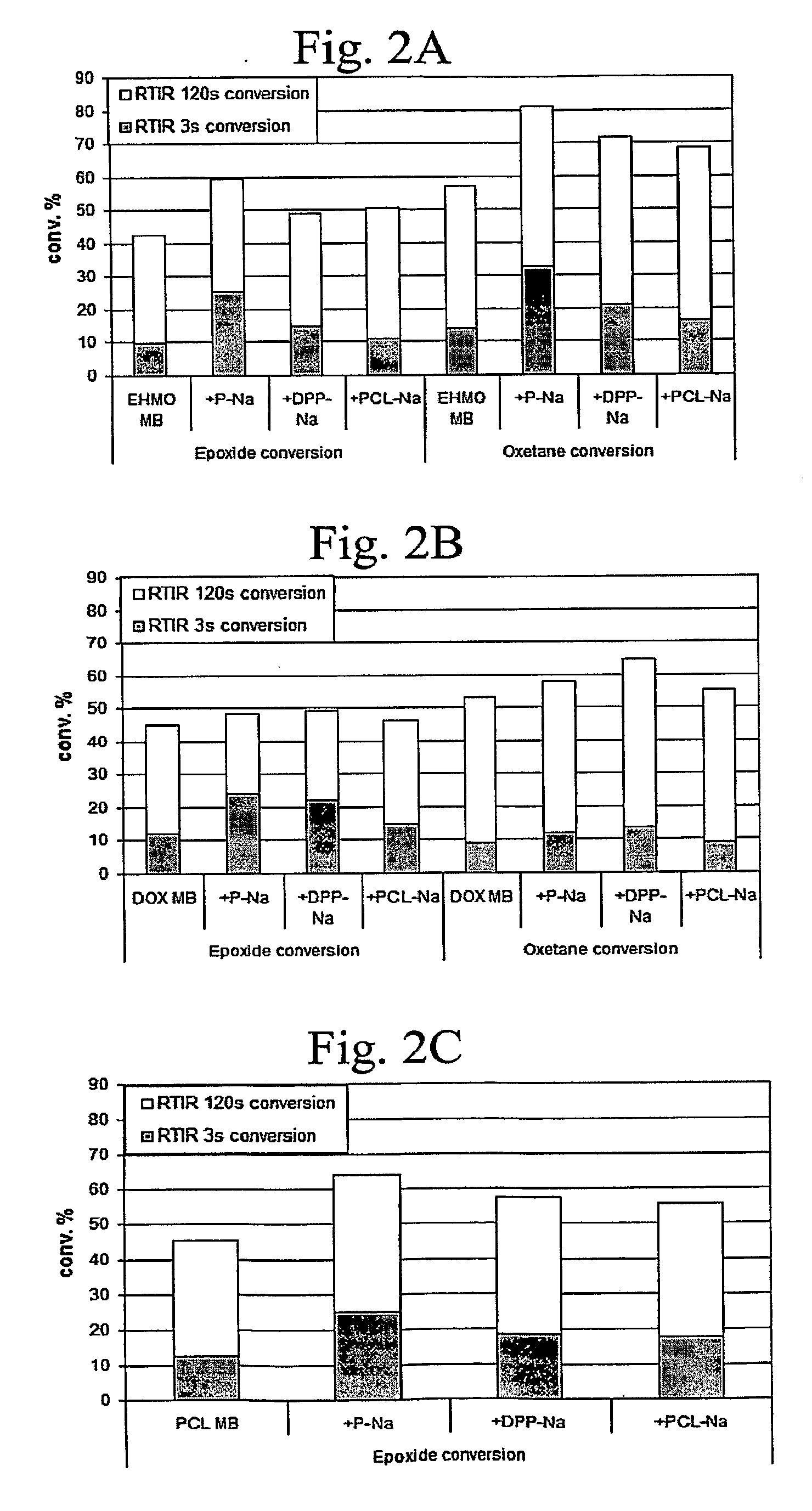Polyol photosensitizers, carrier gas UV laser ablation sensitizers, and other additives and methods for making and using same
a technology of photosensitive and carrier gas uv laser ablation, which is applied in the field of polymer films and additives, can solve the problems of unsuitability, limiting the effectiveness of cationic uv curable systems, and the speed of cure and reactive functional group conversion still not as high, so as to improve the uv laser ablation performance of coatings
- Summary
- Abstract
- Description
- Claims
- Application Information
AI Technical Summary
Benefits of technology
Problems solved by technology
Method used
Image
Examples
example 1
Synthesis and Study of Novel Polyol Bound Photosensitizers for Cationic UV Curable Systems
[0095]In this Example 1 and in the Following Examples 2 and 3, we describe the synthesis of a group of novel polyol bound cationic UV photosensitizers which possess multiple internal hydroxyl groups near the UV absorbing chromophore molecule. It is believed that the proximity of the multiple internal hydroxyl groups to the UV absorbing chromophore molecule allows for an intramolecular interaction between at least some of these hydroxyl groups and the chromophore. It is believed that this unique structural feature of these polyol bound photosensitizers results in a pronounced cationic photosensitization effect. An Intramolecular Hydrogen Abstraction Photosensitization (“IHAP”) mechanism is proposed in order to account for the experimental observations. The photosensitizers that function through the proposed IHAP mechanism are called Intramolecular Hydrogen Abstraction Photosensitizer (“IHA-PS”) ...
example 2
Details of the Synthesis of Novel Polyol Bound Photosensitizers and Preparation of Coating Formulations
[0096]The chemicals used in the photosensitizer synthesis and coating formulations are listed in Table 1. HPLC grade tetrahydrofuran (“THF”) and acetone, triethylene amine (“TEA”), and AMBERLYST™ 15-sulfonic acid functionalized ion exchange resin were obtained from Aldrich. All materials were used as received.
TABLE 1Chemical Structure / NameAbbreviationSourceDescriptionUVI 6974PIDowMixed triarylsulfoniumhexafluoroantimonate saltin propylene carbonateUVR 6110ECCDowUVR 6000EHMODowTone 31PCLDowOXT-221DOXToagosei Co. Ltd.1-Naphthol chloride1-NaClAldrichDimethyl 2,6- naphthalene dicarboxylateNDCAldrichP1000pPerstorp Polyols Inc.DPP 130DPPPerstorp Polyols Inc.PP50sPPPerstorp Polyols Inc.
[0097]A series of polyol-bound and non-polyol bound cationic UV photosensitizers were synthesized and characterized as follows.
[0098]The structures and nomenclature of the cationic UV photosensitizers are s...
example 3
Results and Discussion of the Synthesis of Novel Polyol Bound Photosensitizers and Experiments Involving their Use in Coating Formulations
[0107]In previous work, the synthesis of bound UV laser ablation sensitizers was reported (Chen, which is hereby incorporated by reference). In that work it was demonstrated that, if a UV chromophore is attached to the components that form the polymer network, UV photopolymerization is not deterred. In Examples 1 and 2 and in this Example 3, we describe the synthesis of a series of polyol bound sensitizers (e.g., P-Na and DPP-Na). The synthesis was motivated, in part, to improve the solubility of the UV laser energy absorbing chromophore (e.g., a naphthalene moiety) in the coating matrix. In order to study the effect of the sensitizers on the photopolymerization behavior, cationic UV curable coatings containing these sensitizers were examined with RTIR experiments in order to determine if these sensitizers would deter the UV curing of the coatings...
PUM
| Property | Measurement | Unit |
|---|---|---|
| thermal stability | aaaaa | aaaaa |
| speed | aaaaa | aaaaa |
| wavelength | aaaaa | aaaaa |
Abstract
Description
Claims
Application Information
 Login to View More
Login to View More - R&D
- Intellectual Property
- Life Sciences
- Materials
- Tech Scout
- Unparalleled Data Quality
- Higher Quality Content
- 60% Fewer Hallucinations
Browse by: Latest US Patents, China's latest patents, Technical Efficacy Thesaurus, Application Domain, Technology Topic, Popular Technical Reports.
© 2025 PatSnap. All rights reserved.Legal|Privacy policy|Modern Slavery Act Transparency Statement|Sitemap|About US| Contact US: help@patsnap.com



